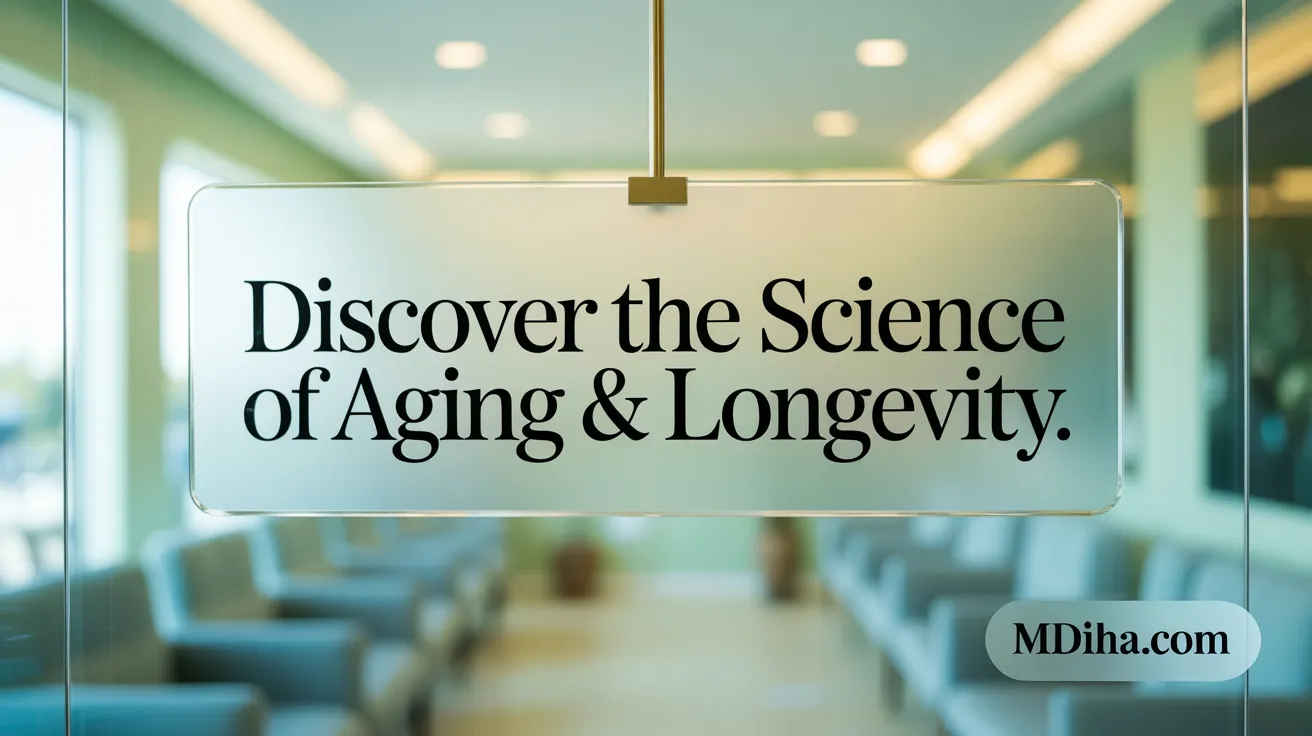Why Customize Your Healthspan Optimization Plan?
As we strive not just to live longer but to live better, the concept of healthspan—the years lived in good health—becomes central to wellness. Unlike lifespan, which measures total years lived, healthspan emphasizes the quality of those years, free from chronic disease and disability. A growing body of research shows that personalized healthspan optimization plans tailored to individual needs, genetics, and lifestyles can profoundly extend both the duration and quality of life. This article explores the science, strategies, and benefits of personalized approaches to healthspan, empowering you to tailor your health journey for longevity and vitality.
Understanding Healthspan and Its Scientific Foundations

What are healthspan and lifespan, and why is extending them important?
Healthspan refers to the period of life during which an individual remains healthy, active, and free from significant chronic diseases or disabilities. In contrast, lifespan is the total number of years a person lives from birth to death. While extending lifespan might mean living longer, increasing healthspan ensures those additional years are lived with vitality and without debilitating conditions (healthspan definition).
Enhancing healthspan is crucial because it improves quality of life, diminishes healthcare costs, and reduces the social and economic burdens associated with age-related illnesses. Lifestyle factors such as healthy eating, regular physical activity, maintaining social connections, and medical advancements are instrumental in promoting healthier aging. The goal is not merely longevity but ensuring the years lived are healthy, meaningful, and independent (Science-backed ways to increase healthspan, Extending your healthspan at 60+).
Scientific research underpins our understanding of healthy aging and longevity
Our comprehension of aging and longevity stems from years of scientific investigation into biological mechanisms at cellular and molecular levels. Key areas of study include cellular senescence, telomere shortening, mitochondrial dysfunction, and epigenetic alterations (Physiological geroscience).
Research has identified that the accumulation of cellular damage, chronic low-grade inflammation, and immune system decline contribute significantly to aging. Experiments with interventions such as caloric restriction, exercise, and pharmacological agents like rapamycin and NAD+ precursors have demonstrated potential in delaying biological aging (A Practical Approach to Healthspan Medicine).
Molecular pathways such as the mTOR and cGAS-STING are targeted to mitigate age-related decline. Additionally, ongoing studies focus on developing biomarkers that accurately reflect biological age and healthspan potential, paving the way for personalized anti-aging strategies (personalized longevity programs).
Tools and biomarkers used to assess healthspan and longevity potential
To evaluate and monitor healthspan, a variety of biomarkers are employed. Epigenetic clocks, including DNAmAge and GrimAge, analyze DNA methylation patterns to estimate biological age, which often correlates with health status and disease risk. Blood-based markers such as inflammatory proteins (e.g., CRP), metabolic indicators, hormone levels, and markers of oxidative stress provide additional insights (Advanced lab testing for healthspan).
Advanced comprehensive assessments, like the Healthspan Assessment Panel, combine various biomarkers to generate an overall picture of biological aging. These tools help predict longevity potential, track the effectiveness of interventions, and tailor personalized aging mitigation plans. Continuous refinement and validation of these biomarkers are essential for translating research into effective clinical applications (Comprehensive Health Risk Assessments).
Understanding these scientific foundations allows us to target the core processes of aging more effectively, with the ultimate aim of extending not just lifespan but healthspan — improving the quality and durability of years lived (Healthspan optimization, Tailored healthcare benefits).
Crafting Personalized Wellness Plans for Optimal Aging

How can wellness programs be personalized to meet individual health and aging needs?
Personalizing wellness programs is a holistic process that begins with a comprehensive assessment of an individual's unique health profile. This includes analyzing genetic predispositions, metabolic markers, and lifestyle factors such as diet, activity levels, sleep habits, and mental health. Advanced diagnostics, like blood biomarker testing, genetic analysis, and microbiome assessments, provide detailed insights that help tailor specific interventions.
Based on these assessments, customized plans are created to address dietary needs, exercise routines, and behavioral changes suited to the individual's goals and preferences. For example, nutritional strategies might leverage nutrigenomics to optimize nutrient absorption, while fitness programs are adjusted for capacity and mobility, especially in older adults. These personalized plans are further enhanced by technology, such as wearable health devices, remote monitoring, and mobile apps, which track biomarkers and activity levels in real time.
Continuous monitoring allows for dynamic adjustments, ensuring sustained engagement and effectiveness. Integrating digital tools like telehealth consultations with experts ensures ongoing support, motivation, and education. Community involvement through support groups or multigenerational activities can also support mental well-being and social connection.
Innovations like virtual reality therapies and online coaching provide accessible mental health support, helping reduce loneliness and improve emotional resilience. Gathering direct feedback through surveys and regular check-ins helps refine the program and caters to evolving needs.
The convergence of personalized health data, technology integration, professional guidance, and community support creates a comprehensive approach that maximizes healthspan, supports healthy aging, and promotes a vibrant, active life at any age.
Lifestyle Interventions and Behavioral Changes to Enhance Healthspan

What lifestyle interventions and behavioral changes contribute to improving healthspan?
Enhancing healthspan involves adopting a broad range of healthy habits aimed at preserving physical, mental, and emotional well-being as we age. Regular physical activity is fundamental; aiming for at least 150 minutes of moderate aerobic exercise weekly, complemented by strength training, can significantly reduce the risk of chronic diseases such as heart disease, diabetes, and cancer (Science-backed ways to increase healthspan, What is healthspan and how can you maximize yours).
Diet also plays a crucial role. Following nutritious, plant-rich dietary patterns like the Mediterranean diet—high in fruits, vegetables, whole grains, lean proteins, and healthy fats—supports bodily functions and reduces inflammation. Avoiding processed foods, limiting high-fat and high-sugar foods, and managing alcohol intake further contribute to healthier aging (Extending Your Healthspan, What is healthspan and how can you maximize yours).
Stress management techniques such as mindfulness, meditation, and social engagement are vital. Maintaining strong social ties has been linked to longer life and better mental health, while managing stress can lower inflammation and decrease disease risk. Ensuring adequate sleep, staying well-hydrated, and maintaining a healthy body weight are additional behavioral factors that bolster overall resilience (Science-backed ways to increase healthspan, Extending your healthspan at 60+).
Physical health is complemented by psychological well-being. Positive outlooks, optimism, and engagement in enjoyable activities can enhance quality of life. Combining these lifestyle interventions with biomedical approaches like regenerative therapies or hormone optimization can dramatically extend healthspan, delaying the onset of age-related ailments (Healthspan optimization, personalized longevity programs).
What holistic lifestyle approaches and pillars support healthy aging?
A comprehensive, holistic approach to aging emphasizes multiple interconnected pillars: physical activity, balanced nutrition, mental stimulation, social connections, and spiritual well-being. Regular movement such as walking, yoga, or resistance training maintains strength, mobility, and cardiovascular health (Optimizing Tailored Health Promotion, Regular exercise for healthy aging).
Nutritional strategies focus on whole, nutrient-dense foods with an emphasis on fruits, vegetables, nuts, and healthy oils, which help reduce inflammation and support cognitive health. Mental activities—reading, puzzles, or learning new skills—keep the brain engaged, reducing cognitive decline (Healthspan medicine basics, Personalized Wellness Plan).
Social engagement is essential. Staying connected through community groups, volunteering, or family interactions fosters emotional resilience and reduces feelings of loneliness. Addressing spiritual needs, whether through meditation, prayer, or reflection, can provide purpose and inner peace (Personalized wellness strategies, Personal wellness plan).
Healthcare strategies like regular screenings, managing chronic conditions, and preventive measures further support aging well. Integrating these dimensions into a personalized regimen aids in maintaining vitality, mental clarity, and an active, fulfilling life well into older age (Personal Wellness Plan, Healthspan medicine basics).
Fostering an environment that encourages healthy lifestyle choices, along with personalized health plans, enhances resilience and prolongs quality years of life, truly supporting healthy aging across all domains (Personalized Health Care, Healthspan optimization).
Medical, Therapeutic, and Pharmacological Innovations in Healthspan Extension
In the quest to extend healthspan—the years of life lived in good health—scientists and clinicians are exploring a range of medical, therapeutic, and pharmacological strategies.
One promising avenue involves senolytics, a class of drugs that target and eliminate senescent cells. These cells, which accumulate with age, contribute to inflammation, tissue deterioration, and age-related diseases. Clearing these cells has shown potential in reducing age-related decline and improving overall health.
Hormone therapies are also being refined to optimize aging processes. Hormone replacement treatments for testosterone, estrogen, and thyroid function aim to support metabolic and physiological health, thereby promoting vitality and resilience in older adults.
Pharmacological agents like metformin, originally used for diabetes, are now under investigation for their anti-aging properties. Metformin's ability to improve insulin sensitivity and reduce inflammation makes it a candidate for broader healthspan applications. Other drugs, such as rapamycin and NAD+ boosters, are also being studied for their capacity to modulate aging pathways.
Emerging gene therapies and gene editing techniques, notably CRISPR/Cas9, offer the potential for targeted interventions at a genetic level. These technologies could correct or modify age-related genetic predispositions, delaying or preventing the onset of chronic diseases.
Supporting these advances are innovative biotechnology platforms, such as proteo-lipid vehicles, which efficiently deliver gene-editing materials and therapeutics to specific tissues.
Large-scale initiatives like ARPA-H’s PROSPR program focus on developing early biomarkers of aging and creating therapies to intervene before significant functional decline occurs. These efforts aim to shift the focus from treatment to prevention, ultimately enhancing quality of life.
Integrating these cutting-edge treatments with personalized health plans—tailored based on individual genetics, biomarkers, and lifestyle—enhances their effectiveness. Combining regenerative medicine, biotechnology, and targeted pharmacology provides a comprehensive strategy to extend healthspan and improve aging outcomes.
Benefits and Integration of Customized Healthspan Optimization Plans

How do customized health and wellness solutions benefit individuals?
Personalized healthspan programs offer significant advantages by tailoring strategies to each person’s unique health profile. These plans consider genetic predispositions, lifestyle factors, and specific health challenges, enhancing intervention accuracy and effectiveness. Individuals experience improved health outcomes through targeted screenings, nutritional guidance, exercise programming, and medication management that align with their physiology and personal preferences.
Such customization fosters greater motivation and adherence, as interventions resonate more deeply with individuals' values and circumstances. This approach also strengthens trust-based relationships with healthcare providers, facilitating ongoing communication and adjustments as health needs evolve as described in Optimizing Tailored Health Promotion.
In organizational settings, personalized wellness options contribute to higher employee satisfaction and engagement. They encourage a health-conscious culture by addressing diverse motivations, promoting inclusion, and supporting sustained participation in health initiatives.
What distinguishes health optimization from preventive medicine?
While both aim to improve overall well-being, health optimization emphasizes enhancing physical resilience, mental vitality, and functional capacity beyond mere disease prevention. It incorporates strategies like regenerative therapies, cellular health, and performance-focused interventions to maximize quality of life.
Preventive medicine primarily seeks to reduce the incidence of chronic illnesses through screenings, vaccinations, and lifestyle modifications. Its focus is on early detection and avoidance of disease onset.
In contrast, health optimization adopts a broader, proactive stance by addressing underlying biological aging processes, such as inflammation and mitochondrial decline. It aims to prolong healthspan—years of life free from significant disabilities—by fostering biological resilience and peak performance.
How can expert consultations and professional guidance aid in health optimization and longevity?
Expert guidance plays a crucial role in navigating complex, emerging health technologies and interventions. Specialists analyze detailed diagnostic data—including genetic testing and biomarker assessments—to craft personalized protocols for health span extension.
Professionals interpret intricate health information, helping individuals understand their risks and how best to address them. They ensure interventions are scientifically validated, safe, and aligned with personal goals, as emphasized in Personalized Health Care.
Moreover, ongoing expert supervision supports the integration of advanced therapies like regenerative medicine, hormone optimization, and digital health tools. Through regular monitoring and adjustments, professionals help maintain optimal health trajectories and maximize longevity.
What innovative digital health technologies support personalized care for longevity?
Cutting-edge digital tools are transforming personalized longevity care. Wearable devices continuously monitor vital signs, activity levels, and sleep patterns, providing real-time data to inform health decisions.
AI-driven analytics and telehealth platforms enable remote consultations, facilitate early detection, and tailor interventions dynamically. The integration of IoT-connected sensors and apps—collectively part of the expanding "AgeTech" ecosystem—supports aging at home safely and independently.
Advanced technologies such as digital biomarkers and predictive modeling accelerate identification of biological aging markers and disease risks. These tools enable precise, personalized interventions—ranging from nutrition to pharmacology—fundamentally shifting longevity care from reactive to proactive.
Together, these innovations foster an accessible, adaptive system, empowering individuals to optimize their healthspan with data-backed, personalized strategies.
Embracing Your Personalized Path to Extended Vitality
Customized healthspan optimization plans represent a transformative approach to living longer, healthier, and more vibrant lives. Rooted in scientific insights and supported by cutting-edge diagnostic and therapeutic technologies, these plans empower individuals to make personalized, evidence-based decisions encompassing lifestyle, nutrition, medical interventions, and behavioral strategies. The integration of expert guidance and digital health innovations ensures continuous adaptation to evolving health needs. By embracing tailored wellness strategies, anyone can enhance their physiological resilience, mental well-being, and overall quality of life, ultimately extending their healthspan alongside lifespan. As the science of aging advances, personalized healthspan optimization stands at the forefront, offering a hopeful and practical blueprint for sustained vitality well into the later decades of life.
